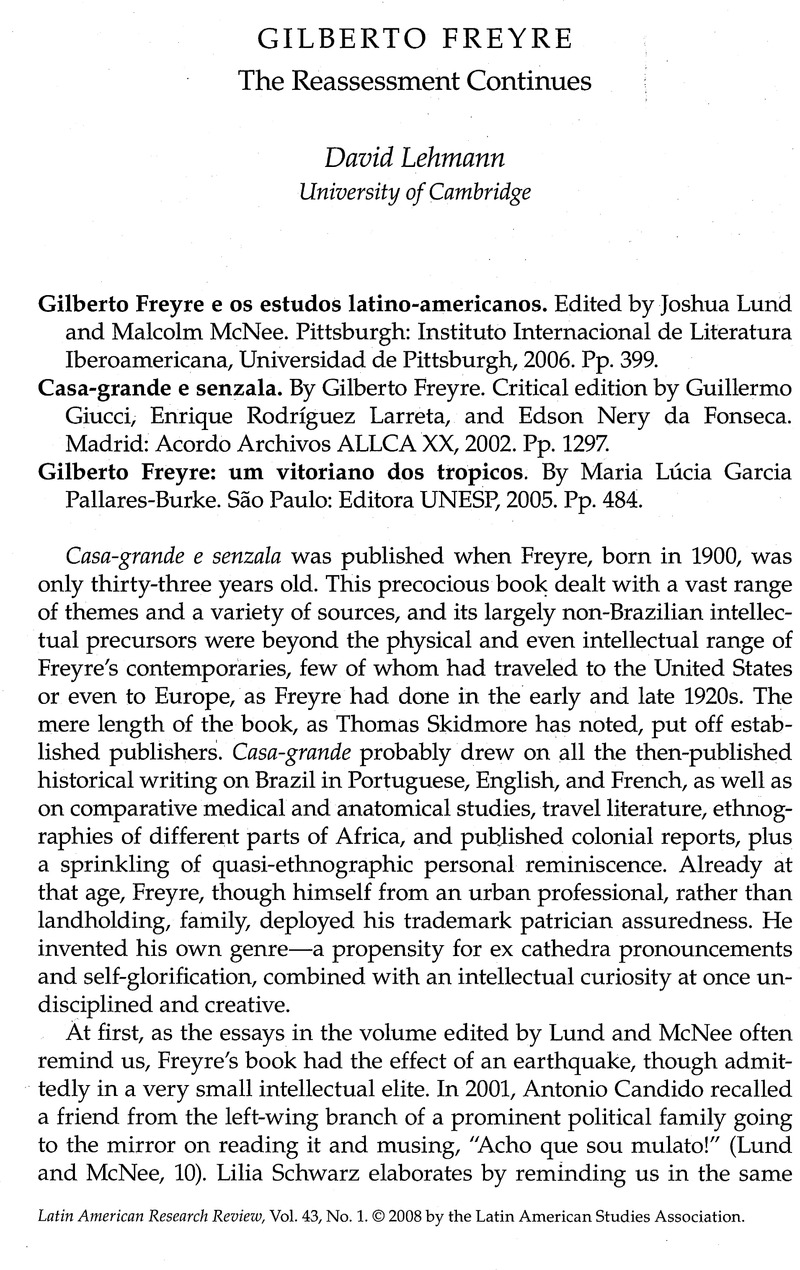Article contents
Gilberto Freyre: The Reassessment Continues
Review products
Published online by Cambridge University Press: 05 September 2022
Abstract

- Type
- Review Essays
- Information
- Copyright
- Copyright © 2008 by the University of Texas Press
References
1. Although commissioned for the modernist Ministry of Education building in Rio de Janeiro, this sculpture was cancelled by Gustavo Capanema, Vargas's powerful minister of education, because the sculptor did not agree with Capanema's Arian conception of the typical Brazilian. The work, which was meant to be twelve meters high, was never finished, and the model was destroyed in what some regard as a suspicious accident. The correspondence and an instructive newspaper article from the Correio da Manhã (23 September 1938) are reproduced in Mauricio Lissovsky and Paulo Sergio Moraes de Sá, Colunas da educação: a construção do Ministério da Educação e Saúde (Rio de Janeiro: Instituto do Patrimonio Histórico e Artístico Nacional, 1996), 224–237.
2. George Reid Andrews, “Brazilian Racial Democracy, 1900–90: An American Counterpoint,” Journal of Contemporary History 31 (1996): 487. At the expense of appearing pedantic, while Andrews says that Freyre directly contrasted Brazilian racial democracy to Nazi racism, the original text in fact refers to social democracy. See Gilberto Freyre, The Masters and the Slaves: A Study in the Development of Brazilian Civilization (Berkeley: University of California Press, 1986), xii. This is a reproduction in paperback of the second edition of Samuel Putnam's translation of 1946, with (yet another) new preface by Freyre and an introduction by David Maybury-Lewis. For Andrews's work on race, see his Blacks and Whites in São Paulo, Brazil 1888–1988 (Madison: University of Wisconsin Press, 1991).
3. Robin Sheriff, Dreaming Equality: Color, Race, and Racism in Urban Brazil (New Brunswick: Rutgers University Press, 2001), 5.
4. Levy Cruz, “Democracia racial: uma hypótese” (Recife: Fundação Joaquim Nabuco, 2002), http://www.fundaj.gov.br/tpd/128.html.
5. Gilberto Freyre, The Mansions and the Shanties: The Making of Modern Brazil, trans. Harriet de Onís (New York: Knopf, 1963), 431.
6. Lêda Rivas, Parceiros do tempo (Recife: Editora Universitaria, 1980). This interview is reproduced in part by Cruz.
7. Fernando Henrique Cardoso, “A espera de Grande industria e favela,” Senhor/Vogue, no. 2 (May 1978): 115–121, original emphasis.
8. Mala Htun, “From Racial Democracy to Affirmative Action: Changing State Policy on Race in Brazil,” Latin American Research Review 39, no. 1 (2004): 60–89.
9. Notably Ricardo Benzaquen de Araújo: Guerra e Paz: Casa Grande e Senzala e a obra de Gilberto Freyre nos anos 30 (Rio de Janeiro: Editora 34, 1994); and Joaquím Falcão and Rosa Barboza de Araújo, eds., O imperador das idéias: Gilberto Freyre em questão (Rio de Janeiro: Fundação Roberto Marinho/Top Books, 2001).
10. Peter Fry, “ ‘Feijoada e soul food‘ 25 anos depois,” in A persistencia da raça: ensaios antropológicos sobre o Brasil e a Africa austral (Rio de Janeiro: Civilizaçao Brasileira, 2005), 147–148; Stuart Schwartz, “Gilberto Freyre e a historia colonial: uma visão otimista do Brasil,” in O imperador das idéias, 101–117.
11. Carlos Lacerda, Depoimento, ed. Claudio Lacerda Paiva (Rio de Janeiro: Nova Fronteira, 1977), 196.
12. Maria Lúcia Pallares-Burke, “A Spectator in the Tropics: A Case Study in the Production and Reproduction of Culture,” Comparative Studies in Society and History 36 (1994): 676–701; Nisia Floresta, O carapuceiro e outros ensaios de tradução cultural (São Paulo: Editora Hucitec, 1996).
13. Freyre, The Masters and the Slaves, xvi–xvii.
14. Benzaquen de Araújo, Guerra e Paz, 208.
15. Asa Briggs, “Gilberto Freyre and the Study of Social History,” in The Collected Essays of Asa Briggs, vol. 1 (Urbana: University of Illinois Press, 1985).
16. Thomas Skidmore, “Raizes de Gilberto Freyre,” Journal of Latin American Studies 34 (2002): 1–20; David Maybury-Lewis, introduction, The Masters and the Slaves, reproduced in Casa-grande e senzala, critical edition, 1111–1116.
17. Beatriz Gois Dantas, Vovó Nagô e Papai Branco: usos e abusos da Africa no Brasil (Rio de Janeiro: Graal, 1988); Patricia Birman, “Cultos de possessão e pentecostalismo no Brasil: Passagens,” Religião e Sociedade 17 (1996): 90–108.
- 12
- Cited by


